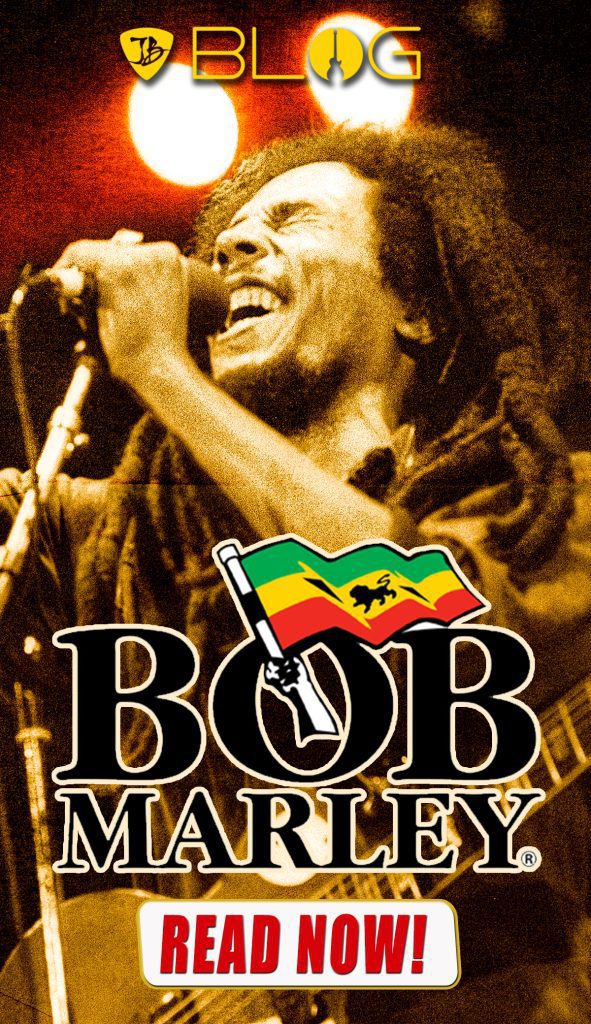Bob Marley
Oh, how we miss him still, but he left us all his beautiful, painful, truthful music that speaks to us and our realities still today” “So Much Trouble In The World … indeed!” When it came to Marley working on musical projects, it was always done with an experimental attitude towards them. Where he would always explore all his options, experiences, and ideas first. Then eventually they became a song with elements of reggae, ska, and a rocksteady vibe. Some even more spiritual later in life. He transcends what the definition of a true music icon can be including the first Jamaican artist to achieve international superstardom. And global superstar!
Furthermore, he had this distinctive vocal and songwriting style that would make you stop and listen and feel something new. When it comes to his career, he followed his heart which led him down his musical path. Still to this day, his songs leave a profound impact in the world.
Check out Crazy Baldhead/Running Away (Live At The Rainbow Theatre – Circa 1977).
Bob Marley, The Musician & Advocate
While things were just not working out in his family situation at the time, at age 14, he leaves home to pursue a music career in Kingston. He becomes a student of local singer and devout Rastafarian Joe Higgs. He finally cuts his first single, “Judge Not,” in 1962 for Leslie Kong, but shortly after he severs ties with the famed producer soon after over a monetary dispute. They sign on with producer Coxsone Dodd’s legendary Studio One and record their debut, “I’m Still Waiting.” Starting out as a five member band, two of the members leave to follow a different direction. And then there was three!
No Worries, because Marley takes over the lead vocal duties, and in early 1964, the group’s follow-up, “Simmer Down,” tops the Jamaican charts. Along with a series of singles including “Let Him Go (Rude Boy Get Gail),” “Dancing Shoes,” “Jerk in Time,” “Who Feels It Knows It,” and “What Am I to Do” follows shortly after, and in all, the Wailers recorded some 70 tracks for Dodd before disbanding in 1966.. Shortly after, He then decides to collaborate with Peter Tosh and Bunny Wailer to create “The Wailers.”
This group later becomes “Bob Marley and the Wailers.” garnering international fame. Also, making Bob Marley, Bunny wailer and Peter Tosh a household name. Bringing worldwide attention to the Jamaican culture, Reggae music and the Rastafari movement.
Check out Bob Marley And The Wailers performing ‘Get Up, Stand Up’ live at The Open Air Festival in Munich, Germany on the 1st of June during the 1980 Uprising Tour.
Live at The Old Grey Whistle, 1973
Bob Marley & The Wailers do a live in-studio performance for London’s Top Gear Radio Show before performing live for BBC Channel 2′s Old Grey Whistle Test. They perform “Stir It Up” and “Concrete Jungle” during this set. This is one of only 2 or 3 times where Bob Marley, Peter Tosh, and Bunny Wailer are captured on video performing together as The Wailers. The Band Line-up Bob Marley, vocals, rhythm guitar
Peter Tosh, vocals, lead guitar, Bunny Wailer, vocals, percussion, Aston Barrett, bass Carlton Barrett, drums, Earl ‘Wya’ Lindo, keyboards.
I chose this video because this was the first one, I saw of the band as a kid on television. I have to say I was mesmerized by the performance. I thought to myself that one day, I would get to see him live in concert if he ever came to south Florida and he finally did! The next-door neighbor lady took us to see the band. Although the traffic was horrifying!
We didn’t get to the show (I believe at the Miami Jai Alai) until it was almost over but we got to see some of it towards the end and yes, he most certainly left an impression even if it was watching the performance from the nose bleed seats. Sadly, he passes on May 11, 1981 at 36.
His Legacy
Considered the patron saint of Reggae. He produces mellow island beats that spread the message of peace, love and positive vibes. Furthermore, Bob Marley is reggae’s foremost practitioner and emissary, embodying its spirit and spreading its gospel to all. Although the Wailers are popular in Jamaica. Not until the group signs with Chris Blackwell’s Island Records in the early Seventies do they capture an international audience.
Their first recordings for Island, Catch a Fire (1973) and Burnin’ (1973), are hard-hitting albums. Furthermore, critic Robert Christgau calls these albums full of what Marley’s “melodic propaganda”. The latter contains “I Shot the Sheriff”. Reggae aficionado Eric Clapton’s version of the song went to #1 in 1974. Which further carries the name of Marley and the Wailers beyond their Jamaican home base.
Meanwhile, Marley’s music continues to find an audience. With sales of more than 10 million in the U.S. alone (probably more than this). The album Legend, a best of spanning the Island Records years (1972-1981) remains to this day, the best-selling album by a Jamaican artist. As well as the best-selling reggae album in history.
To learn more about this Amazing artist check out his web-site: https://www.bobmarley.com/ – There is a lot of great stuff to check out!
Video Credits: Crazy Baldhead – Bob Marley Website, Bob Marley Website – Get Up, Stand Up (Live at Munich, 1980), Bob Marley Website – Bob Marley & The Wailers – Stir It Up (Live at The Old Grey Whistle, 1973), ZAIDINREGGAE – Bob Marley Live 80 HD “Redemption Song – Could You Be Loved.


